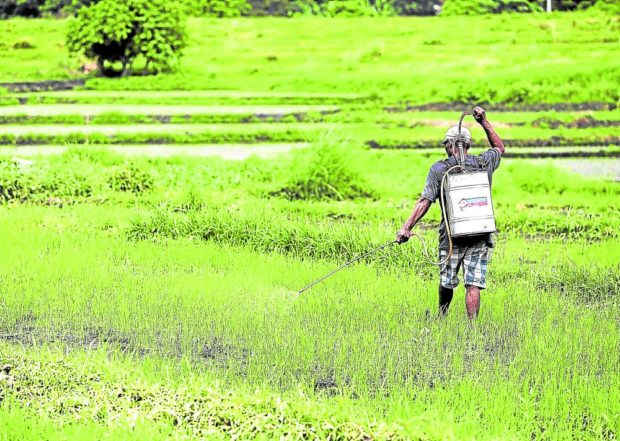
A farmer sprays herbicide on a rice field in Barangay Bunga in Tanza, Cavite. INQUIRER PHOTO / RICHARD A. REYES
The Philippines, despite being blessed with vast agricultural lands, has increasingly relied on the importation of key commodities to augment the supply of food products in previous years.
Under the Duterte administration, the Department of Agriculture (DA) sourced agricultural goods from abroad to feed the entire country. In the first half of 2022 alone, the agency authorized the importation of meat, fish and sugar to cover supply shortfalls and keep local prices in check.
This food importation policy was widely criticized by various agriculture groups, who not only claimed that farmers and fishers incurred billions of pesos in losses, but said the policy also eroded their productivity.
The sector’s growth has remained stunted over the years, with the latest data from the Philippine Statistics Authority (PSA) showing that agricultural production in the first quarter of this year dropped by 0.3 percent. In the same period last year, output declined by 3.4 percent.
Typhoons, ASF
While the government’s inclination for importation has been blamed for the lackluster performance, there are other major factors at play that have influenced agricultural production. These include the typhoons that ravage the country each year as well as various animal diseases, including the African swine fever and highly pathogenic avian influenza or bird flu.
The sector has also remained the smallest contributor to economic growth over the last five years. Based on the figures from the PSA, the sector’s contribution to the gross domestic product in 2021 stood at about 10 percent, making this sector the smallest contributor to economic growth. It is much smaller than the 61 percent contribution of services or the 29 percent share of the industrial sector.
But amid low farm input, the agriculture sector has made significant strides. For instance, in 2021, the country reached a new record-high palay (unhusked rice) production of 19.96 million metric tons (MT), surpassing its previous record high of 19.29 million MT recorded a year ago. Likewise, the production of corn, considered one of the country’s staple crops, rose by 2.2 percent to 8.3 million MT from 8.1 million MT, another record harvest. The department attributed the all-time high palay and corn harvests to its various programs benefiting rice and corn producers.
And just before President Duterte ended his term, he issued Executive Order No. 172, or the Coconut Farmers and Industry Development Plan, to serve as the basis for utilizing the P75-billion coco levy fund through various programs and projects. Prior to that, Mr. Duterte signed into law Republic Act No. 11524 or the Coconut Farmers and Industry Trust Fund, which paved the way for releasing the multibillion-peso coco levy fund to revive and modernize the country’s coconut industry.
Dark clouds ahead
The agriculture sector—already plagued with daunting and overwhelming problems—may find itself in deep trouble even beyond the Duterte administration. Russia’s war against Ukraine since February this year added a challenge it needs to overcome to end the unabated increases in food prices. It does not help that global food markets are tightening and the cost of producing agricultural goods has skyrocketed to record highs.
For a net importer like the Philippines, the Russia-Ukraine conflict has a large impact on the country’s food security, something that President Marcos needs to address.
Former Agriculture Secretary William Dar—who had warned the Philippines would feel the strain of the global food crisis the most in the last quarter of 2022—laid out the list of priorities the incoming administration should work on its first 100 days to spur the vital sector’s growth.
The immediate litmus test for the Marcos administration is ensuring enough food amid threats to the supply chain. Rice production alone in the first semester was projected to have decreased by 6.8 percent as farmers reduced their fertilizer usage, the cost of which has nearly tripled as of this writing.
Mr. Marcos is not only veering away from the food importation policy of his predecessor, a move widely welcomed by various stakeholders, but also placed a high priority on agriculture, saying successors of his father had fallen short of achieving food sufficiency.
“The role of agriculture cries for the urgent attention that its neglect and misdirection now demands. Food self-sufficiency has been the key promise of every administration. None but one delivered,” said Mr. Marcos in his inaugural speech.
The first item on the DA’s agenda is to ensure sufficient food supply for the remainder of 2022. He said the agency would explore all ways to increase production such as rice and corn, among the staple of Filipino consumers, as well as chicken.
“We have to attend to the impending food crisis that it seems will be visiting us in the next two quarters. When we look around the world, everyone is preparing for it,” he told high-ranking officials during the DA’s executive committee meeting.